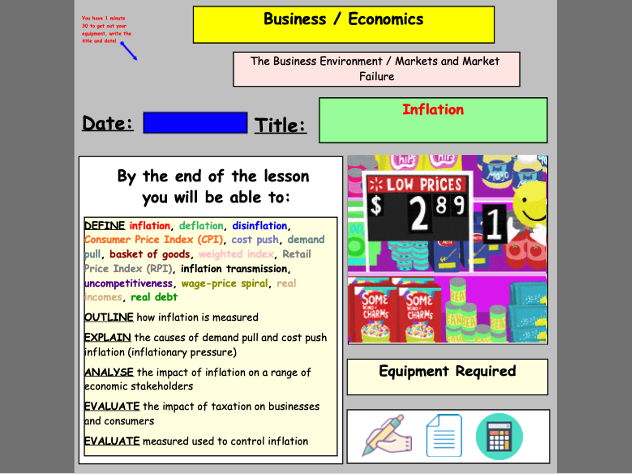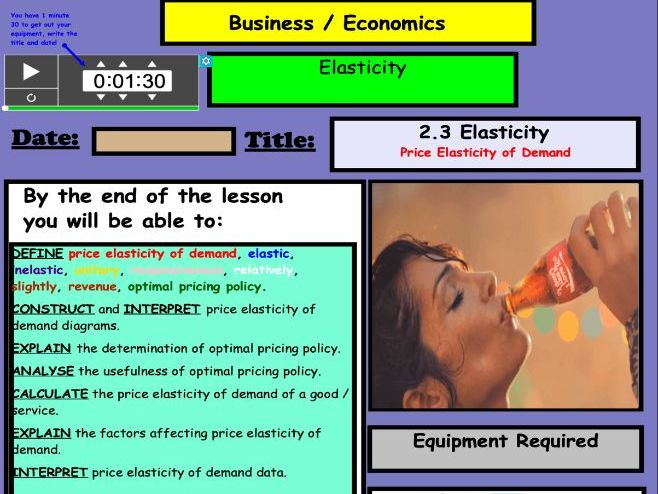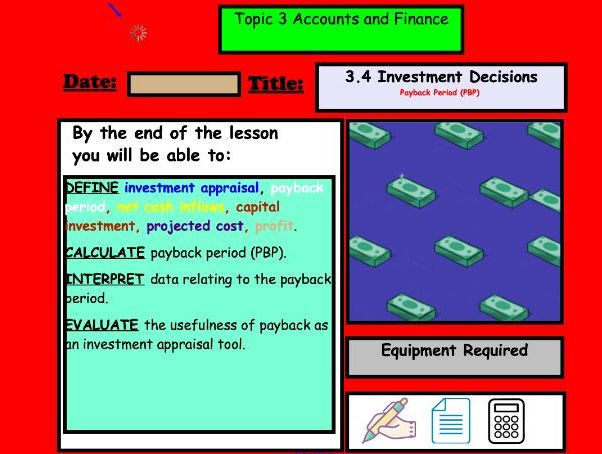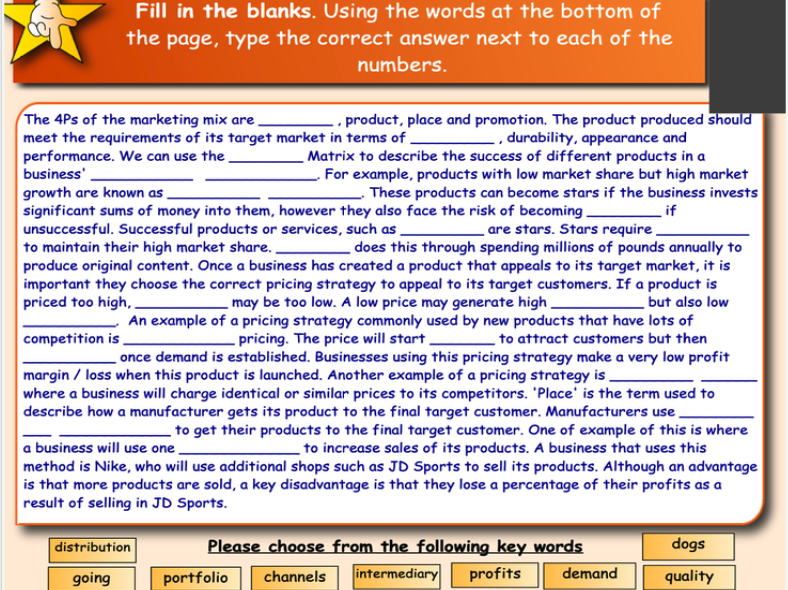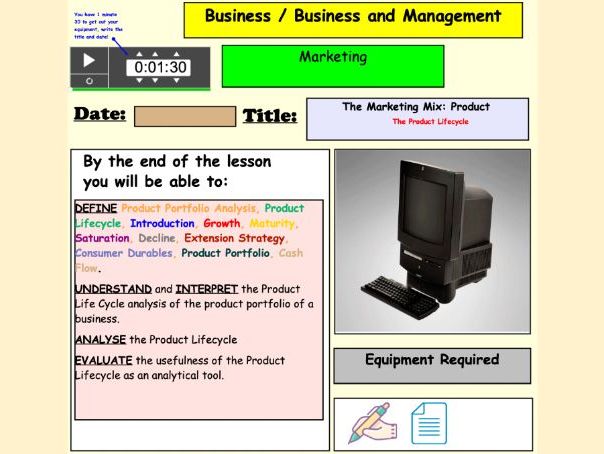83Uploads
9k+Views
5k+Downloads
Business and finance

Inflation
Included in this PowerPoint:
A detailed and colourful title slide that outlines the key learning outcomes and equipment required for the lesson
A starter activity where students are required to guess how the price of 5 goods and services has changed over time (closest for each round wins). Students really enjoy this activity
Explanation of why / when inflation becomes a problem, how it affects incomes and sectors where incomes have risen lower and higher than inflation
Explanation in basket of goods / weighted index
Step by step explanation of how inflation is calculated using weighted index
Activity (with answers) where students are required to calculate inflation changes using a weighted index
Activity (with answers) - identify which goods and services have been recently added and removed from the basket of goods
Explanation of difference between demand-pull and cost-push inflation with examples
Diagrams for both types of inflation
Presentation is detailed and colourful throughout
There are 52 slides in total and this presentation took me an hour and a half to go through.

Advertising, Media and Peer Pressure
A financial education lesson on advertising, media and peer pressure.
Included:
Colourful and interactive slides with timers, animations and videos
Activities (with answers) throughout
Worksheet included
Detailed notes
There are 37 slides in total and this lesson took me an hour and a half to go through

Eduqas Business A Level Model Answers
Please find some examples of model answers from Paper 1 of 2022. I’ve included explanations of exam technique on many of the questions.
Please be aware - ARCADE-J is a mnemonic I use with my students for questions that require evaluation, such as Assess, Recommend, Consider, Advise, Discuss, Evaluate, Justify

Price Elasticity of Demand
Colourful. Engaging. Informative. This PowerPoint has been creating to introduce students to the concept of price elasticity of demand.
Included in this PowerPoint:
A detailed and colourful title page, highlighting the skills that will be covered over the duration of this topic
A starter activity where students need to rank in order which goods / services would be most to least affected by a change in price
Discussion points
Slides detailing how price elasticity of demand is calculated, with an example
Slides explaining what the numerical values mean (how to interpret them)
Calculation questions with answers
Explanation of the factors affecting price elasticity of demand
This resource took me one hour to go through as a class

Types of Taxation (Direct and Indirect)
A colourful and detailed presentation that explores types of taxation. Included in this presentation:
A fun Catchphrase starter activity where students have to look at images to guess the name of a product or service (my students love this!)
An initial true or false quiz about types of taxes (England specific)
4 slides illustrating how much tax revenue the UK generates in comparison to other countries and how that tax revenue is spent. A sample payslip is also shown to illustrate some of the deducations are taken from income tax
Colourful and detailed examples of the main forms of tax students need to know about (income, corporation, VAT, National insurance, business rates)
A ‘how much income tax does Boris pay!’ activity that students love. It illustrates that income tax brackets are different at different thresholds of income
Disadvantages of taxation
Useful tips and notes as to how to evaluate a question that refers to taxation
This lesson took me an hour to complete

Payback Period
Colourful slides, animations, video links, fun activities, as well as questions (with answers provided) are all included in this engaging and informative lesson on calculating the payback period, applicable to all syllabi
Included in the lesson is:
A fun (and very popular with my students!) Catchphrase starter activity where students have to guess the name of a well-known brand or product from a selection of pictures. Answers are provided.
An eye-catching slide used to explain the purpose of the lesson and introduce the terms capital investment appraisal.
An explanation of what it means to invest
Contextualised examples and explanations of what investing is with colourful slides and video links provided (a Bitcoin video is included as well as a link to live house price updates)
A ‘guess the price of the good’ activity that demonstrates reasons why people make investments (to get a return on their investment)
Examples of real business investments (Facebook purchasing WhatsApp, Oculus, extra warehouses for servers)
Explanation and step by step demonstration of how to calculate the payback period
A 10 - 15 minute activity where students need to calculate the payback period. Answers provided.
An explanation as how to evaluate the payback period
It took me a lesson and a half to go through all of the content

Globalisation / Introduction to International Marketing
Using MCDONALD’S TSUKIMI BURGER, Tesco’s failure to succeed in the US, Apple’s failure to succeed in India, and many others, this PowerPoint seeks to explore the reasons why businesses wish to sell in international markets, the challenges and constraints.
Included in this PowerPoint:
A detailed title page, outlining the key skills covered in this topic
A recap on moving averages with answers. This topic is included in some syllabi earlier in the marketing unit but can be deleted if not required
A starter activity introducing the concept of globalisation where students need to match McDonalds products based on the country whey are sold
(demonstrating how products need to be adapted based on the market they are targeting). Answers are provided
An explanation of reasons why businesses choose to sell products in overseas markets
A contextualised example for each reason
Detailed explanations as to each of the reasons why how marketing activities need to change depending on which country goods are being sold
Video 1: Reasons why Tesco failed in US (poor marketing)
Video 2: Reasons why Apple failed in India (poor marketing)
Introduction to some of the factors that make trade between countries easier
This lesson took me an hour and a half to go through.

Maslow's Hierarchy of Needs
Full resource (68 slides) on Maslow’s hierarchy of needs.
Included in this resource:
Colourful and interactive title page , including timer and auto date
Catchphrase starter activity (with answers)
Step by step explanation of each need in the hierarchy
Contextualised examples
Trivia activity
Exam skills activity with answers

Fraud and Identify Theft
This is designed as a follow on lesson to my previous financial education lesson on advertising, media and peer pressure but can be taught as a standalone lesson.
Including in this lesson:
Guess the question starter activity
Explanations of types of fraud, such as phishing and vishing
Videos
Activities with answers

Business Growth (Business and Economics)
Complete resource that explores organic and inorganic growth as well as constraints on growth

Marketing Mix RECAP STARTER
A fill the blanks activity on the 4Ps with emphasis on Boston Matrix
Answers are included
This is useful as a starter activity or plenary

Average Rate of Return
Included in this lesson:
A detailed and colourful title slide, including all learning objectives for this topic
A recap starter activity on calculating the payback period (answers included)
An explanation slide as to what the lesson is about; providing an overview of the problems of relying solely on the payback period as a method of investment appraisal and why other methods are also needed
Explanation of what ARR is
A scenario showing how ARR is calculated
An evaluation of ARR
There are 22 slides in total and it took me around 30 minutes to go through the presentation.

Market Structures and Competition
This lesson can be used either to teach Business students about competition, market structures and how consumers can be affected by anti-competitive practices OR to teach Economics students about the different features of market structures and why competition / a lack of competition affects different stakeholders.
Included in this lesson:
A colourful and detailed title slide outlining the key learning objectives
An income elasticity of demand starter activity suitable for both Business and Economics students (calculation / explain / diagram question). A printable slide of the questions has been provided with a detailed answer key on next slide for peer marking.
A detailed and contextualised example of how a lack of competition affects different stakeholders (Epic Games legal battle with Apple over Fortnite)
Brainstorming activity on competition
A rank in order activity on types of competitive markets
Detailed notes on competition, monopolies, oligopolies, monopolistic competition, perfect competition, Game Theory, types of anti-competitive practices such as Cartels, OFT.
This presentation contains 37 slides and took me an hour to go through with my students.

Business Location
A 20 slide PowerPoint presentation outlining the qualitative and quantitative factors businesses consider when choosing a business location.
The PowerPoint is colouful, informative and includes a ‘Tenable’ game show PowerPoint where students have to identify 10 common reasons why businesses fail

Marketing Mix - Price
This resource is a 58 slide PowerPoint presentation that gives a comprehensive overview of pricing strategies. Included in this resource:
A colourful title page outlining the learning objectives
A fun catchphrase starter activity where students have to guess the name of a business / product from the pictures given [answers included]
A critical path analysis recap activity [answers included]
An introductory explanation of the importance of pricing products correctly
Detailed explanations with examples of market-based, competition-based and cost-based pricing strategies
Colourful examples provided throughout
Calculation activities [with answers] for the cost-based pricing strategies
Colourful gifs and animation are included throughout
This lesson took me just over an hour to go through with students.

Product Lifecycle
Included in this PowerPoint presentation;
A colourful title slide outlining the key learning objectives
A fun Catchphrase starter activity that my students adore!
An introductory slide explaining what the lesson is about
An introductory game where students have to recognise brands of drinks currently / previously owned by Coke (this activity links into product lifecycle)
A hyperlinked video about the rise and fall of Subway (10 mins in length)
Detailed and colourful notes on what the product lifecycle is and what happens at each stage
A simple class activity where students have to be creative and think about how to extend the product lifecycle for 4 random products (I get students to either stand up and explain their suggestions / draw them)
Colourful gifs and animations are included throughout to ensure full engagement from students
This lesson contains 38 slides and took me a full hour to complete with all the activities included

Market Share
This presentation includes:
A colourful title slide with learning objectives and clickable timer to give students a minute and a half to get down the title
Detailed notes providing explanations of markets, market growth, calculation of market share, how market share increases as well as the benefits of high market share
3 mini activities; 1 - Calculating market share, 2 - Which markets are growing and shrinking in size 3 - Which business is the market leader in 4 different industries
This lesson took me 30 minutes to go through with my students

Franchises / Franchising
This PowerPoint is a 20 slide resource that containd the following:
A colourful title slide with lesson objectives and animations
An editable ‘guess the starter’ activity
Franchising logo activity
McDonalds information video
Notes
Additional activities
This presentation took me 45 minutes to go through with my students

Sales Forecasting, Market Analysis Worksheet
This worksheet contains a range of sales forecasting and market analysis activities. All answers are included.
Included in this worksheet are activities on:
Market share
Interpreting bar charts
Scatter diagrams
Line of best fit
Extrapolation
Moving averages
Positive, negative or unrelated correlation

Demand (SMART NOTEBOOK VERSION)
Please note that this is a SMART NOTEBOOK presentation and not a PowerPoint presentation

